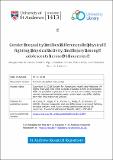Files in this item
Gender inequality and sex differences in physical fighting, physical activity, and injury among adolescents across 36 countries
Item metadata
| dc.contributor.author | de Looze, Margaretha | |
| dc.contributor.author | Elgar, Frank J. | |
| dc.contributor.author | Currie, Candace | |
| dc.contributor.author | Kolip, Petra | |
| dc.contributor.author | Stevens, Gonneke | |
| dc.date.accessioned | 2020-03-06T00:32:04Z | |
| dc.date.available | 2020-03-06T00:32:04Z | |
| dc.date.issued | 2019-05 | |
| dc.identifier | 256435257 | |
| dc.identifier | 6aa75050-503c-47e9-bbf2-b63e49dcd17c | |
| dc.identifier | 85062356314 | |
| dc.identifier | 000464975900017 | |
| dc.identifier.citation | de Looze , M , Elgar , F J , Currie , C , Kolip , P & Stevens , G 2019 , ' Gender inequality and sex differences in physical fighting, physical activity, and injury among adolescents across 36 countries ' , Journal of Adolescent Health , vol. 64 , no. 5 , pp. 657-663 . https://doi.org/10.1016/j.jadohealth.2018.11.007 | en |
| dc.identifier.issn | 1054-139X | |
| dc.identifier.uri | https://hdl.handle.net/10023/19605 | |
| dc.description.abstract | Purpose: Sex differences in adolescent health are widely documented, but social explanations for these sex differences are scarce. This study examines whether societal gender inequality (i.e., men's and women's unequal share in political participation, decision-making power, economic participation, and command over resources) relates to sex differences in adolescent physical fighting, physical activity, and injuries. Methods: National-level data on gender inequality (i.e., the United Nations Development Program's Gender Inequality Index) were linked to health data from 71,255 15-year-olds from 36 countries in the 2009–2010 Health Behaviour in School-Aged Children study. Using multilevel logistic regression analyses, we tested the association between gender inequality and sex differences in health while controlling for country wealth (gross domestic product per capita). Results: In all countries, boys reported more physical fighting, physical activity, and injuries than girls, but the magnitude of these sex differences varied greatly between countries. Societal gender inequality positively related to sex differences in all three outcomes. In more gender unequal countries, boys reported higher levels of fighting and physical activity compared with boys in more gender equal countries. In girls, scores were consistently low for these outcomes; however, injury was more common in countries with less gender inequality. Conclusions: Societal gender inequality appears to relate to sex differences in some adolescent health behaviors and may contribute to the establishment of sex differences in morbidity and mortality. To reduce inequalities in the health of future generations, public health policy should target social and cultural factors that shape perceived gender norms in young people. | |
| dc.format.extent | 7 | |
| dc.format.extent | 661487 | |
| dc.language.iso | eng | |
| dc.relation.ispartof | Journal of Adolescent Health | en |
| dc.subject | Gender inequality | en |
| dc.subject | Adolescence | en |
| dc.subject | Physical fighting | en |
| dc.subject | Physical activity | en |
| dc.subject | Injury | en |
| dc.subject | Europe | en |
| dc.subject | North America | en |
| dc.subject | RJ101 Child Health. Child health services | en |
| dc.subject | 3rd-DAS | en |
| dc.subject | SDG 3 - Good Health and Well-being | en |
| dc.subject | SDG 5 - Gender Equality | en |
| dc.subject | SDG 10 - Reduced Inequalities | en |
| dc.subject.lcc | RJ101 | en |
| dc.title | Gender inequality and sex differences in physical fighting, physical activity, and injury among adolescents across 36 countries | en |
| dc.type | Journal article | en |
| dc.contributor.institution | University of St Andrews. Population and Behavioural Science Division | en |
| dc.contributor.institution | University of St Andrews. WHO Collaborating Centre for International Child & Adolescent Health Policy | en |
| dc.contributor.institution | University of St Andrews. Child and Adolescent Health Research Unit | en |
| dc.contributor.institution | University of St Andrews. School of Medicine | en |
| dc.identifier.doi | 10.1016/j.jadohealth.2018.11.007 | |
| dc.description.status | Peer reviewed | en |
| dc.date.embargoedUntil | 2020-03-06 |
This item appears in the following Collection(s)
Items in the St Andrews Research Repository are protected by copyright, with all rights reserved, unless otherwise indicated.

